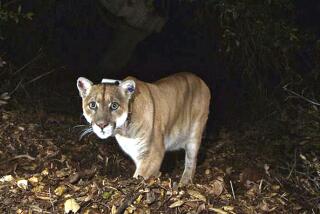Street Wise : A Slow Solution for Those Tired of Life in the First Lane
- Share via
Mardi Brady would like to see a law fixing the highway speed limit at 25 m.p.h. for a few hours a week--say dawn to 9 a.m. on Saturdays and Sundays--so sightseers could poke along and enjoy the scenery.
As it is, she complains, she is hurried, harassed and horrified by huge trucks honking horns and blowing past her and by sports-car fiends screeching around her with malignant backward glances.
Alas, since all life in California is related to the automobile and its speed, a 25-m.p.h. highway speed limit, even for a few hours on weekends, is not likely to become a reality.
I suppose any competent statistician could work out the loss to commerce that would result from just such an adjustment in speed. It would probably run into hundreds of millions of dollars.
During those early hours, the trucks that carry our fruits and vegetables and milk and eggs and beef and chickens and furniture and cars from one end of the state to the other are really high-rolling it along the highways and freeways.
It would be sheer economic disaster to slow them down from their usual 65 m.p.h. (which is 10 m.p.h. over the speed limit) to a mere 25.
Any legislator who proposed such madness would be digging his own political grave, and no governor who hoped to go on to the White House would dare to sign such a bill.
Still, Brady creates a nostalgic picture of the way it used to be when everyone wasn’t in such a hurry.
“I remember poking along the Ventura Freeway between Calabasas and Brent’s Junction and seeing a doe and fawn drinking from a stream. The kids had been counting dairy cattle; whoever counted the most of a certain color in 15 miles won.”
I have an idea that there are millions of children in urban California who have never seen a cow except on television, if even there, since very few movies and TV shows these days are bucolic enough to show cows, sheep or chickens. Their pastoral scenes usually show automobiles colliding or plummeting off cliffs in a fireball.
Milk comes from plastic bottles or cardboard cartons; eggs come from egg cartons, a commercial shape that seems to have inspired much urban architecture.
And the only fawns and does children are likely to see, unless they live high in Bel-Air or the Santa Monica Mountains, are at the zoo.
“I remember driving down from Big Sur on Highway 1 one morning,” Brady recalls, “and seeing a big mountain lion padding toward us across one of those lovely arched bridges. There was plenty of room and time to stop and watch him finish his stroll before he lunged up the hillside on our side of the bridge.”
I have never seen a mountain lion in the wild, but I heard one scream in the Sierra Nevada during one of the summers that my son was working in the mountains as a packer. From the way the state and national parks are being overrun by automobiles, it won’t be long, I suppose, before the lion’s scream is unheard even in the wilderness--what’s left of it.
Mrs. Brady fantasizes: “Speed limits designed especially for sightseers . . . would allow die-hards like me and my family to slowly view the roadside wonders at our leisure and not miss the details of such sights as the spectacular purple California lilac tree glimpsed all too briefly recently on San Marcos Pass.
“I am not desirous of slowing anyone on their rounds every day or limiting their pleasures in handling a car at high speed. I just want some time--not even an equal amount--to do my own thing!”
While I think it is sadly naive of Mrs. Brady to imagine that such a law would ever pass, I think she may be premature in deploring the complete loss of roadside scenery.
It’s a matter of perspective. The Pacific Ocean is so big that one can see it quite well and enjoy its moods and colors even while traveling alongside it at 65 m.p.h. (You have to go 65 to keep from being blown aside by the trucks.)
You can still drive up 101 to San Luis Obispo, and I guarantee that you will see hundreds of black-and-white cows, and brown cows, too, gathered in the shade under the live oaks, and a number of beautiful California barns.
Highway 1 up the coast from Morro Bay to Monterey is still among the world’s scenic glories, though of course you will have to expect to be passed by manic sports-car drivers, buzzing like hornets as they downshift to go around you.
And there is one advantage in driving the freeways and highways from dawn to 9 a.m., even though the trucks are out and the speed limit is unchanged: Most of the night’s drunks will be home in bed.
More to Read
Sign up for Essential California
The most important California stories and recommendations in your inbox every morning.
You may occasionally receive promotional content from the Los Angeles Times.













